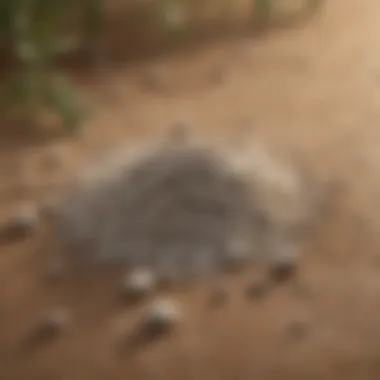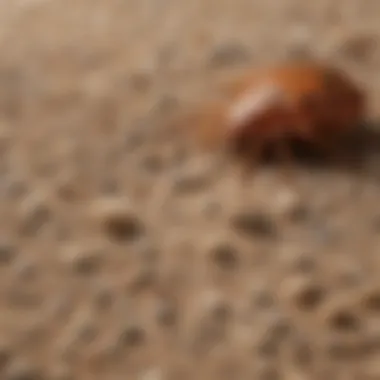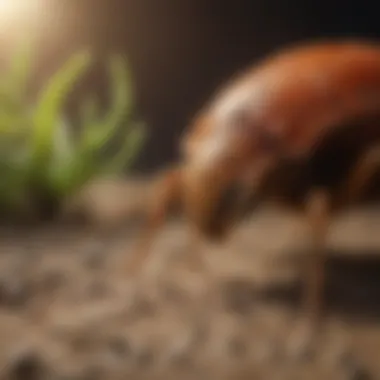Diatomaceous Earth: A Natural Solution for Bed Bugs


Intro
Diatomaceous Earth (DE) has gained recognition as a natural pesticide for controlling bed bug infestations. This article aims to explore its efficacy, offering insights into the chemical properties, application methods, and its comparative effectiveness relative to traditional chemical treatments. Bed bugs, known for their resilient nature, pose significant challenges in both residential and agricultural settings. With increasing concerns over chemical pesticides, understanding alternatives like diatomaceous earth becomes paramount for informed decisions.
Research and Data Analysis
Understanding Diatomaceous Earth
Diatomaceous Earth is composed of tiny fossilized aquatic organisms known as diatoms. These particles have unique physical properties that make them effective in pest management. DE acts through desiccation; it absorbs the oils and fats from the exoskeletons of insects, leading to dehydration and ultimately death. Given the rise in bed bug infestations, research into DE's effectiveness has expanded.
"Diatomaceous Earth has emerged as a promising alternative for those seeking non-chemical solutions to pest problems, particularly with bed bugs."
Latest Trends in Pest Control
- Growing Interest in Natural Solutions: An increasing number of individuals are turning towards natural pest control methods due to concerns about the side effects of chemical pesticides on health and environment.
- Safety Protocols: Implementing best practices in the use of DE ensures it can be a part of integrated pest management strategies without compromising safety.
Statistical Insights into Efficacy
Several studies suggest diatomaceous earth can effectively reduce bed bug populations. While results vary, a significant reduction rate has been observed in infested areas treated with DE. This suggests a promising avenue for further research and application.
Application Methods
Best Practices for Application
For optimal results, consider the following methods while applying diatomaceous earth:
- Target Infestations: Focus on where bed bugs are known to hide, like cracks, crevices, and bedding.
- Fine Application: Use a dust applicator for an even layer of DE without creating large piles.
- Reapplication: This is vital after cleaning or heavy activity in the treated area to ensure consistent exposure to pests.
Safety Considerations
While DE is generally considered safe for humans and pets, precautions should still be taken:
- Wear a mask to avoid inhalation of particles during application.
- Seal areas to prevent cross-contamination in other living spaces.
Integrated Pest Management Strategies
In conjunction with diatomaceous earth, effective pest management should include:
- Monitoring and Inspection: Regularly check for signs of infestation to catch any reinfestations early.
- Hygiene Practices: Clean bedding and living spaces thoroughly to minimize potential habitat for bed bugs.
- Combination Treatments: Consider combining DE with other non-chemical methods to increase overall efficacy.
Finale
Diatomaceous Earth presents a viable alternative for those combating bed bug infestations. Its unique properties, coupled with proper application and safety measures, make it an interesting option for pest control. As bed bug populations continue to be a concern, further exploration into natural solutions like DE will undoubtedly contribute to effective management strategies.
Intro to Bed Bugs and Pesticides
Understanding bed bugs and their management is crucial in today's context of pest control. Bed bugs, as nocturnal parasites, have exhibited a noteworthy resurgence over the past two decades, presenting significant challenges for homeowners and pest control professionals alike. Their ability to adapt and resist conventional pesticides necessitates exploration into alternative management strategies that are both effective and safe. This article delves into the intricate relationship between bed bugs and pesticides, particularly focusing on the promising role of diatomaceous earth.
Overview of Bed Bug Infestations


Bed bug infestations are a persistent problem in various settings, particularly in urban environments. These stubborn insects, Cimex lectularius, thrive in crevices and harborages close to human habitation. They are often introduced through furniture, luggage, and clothing. Infestations can develop quickly, leading to a significant disruption in daily life. Common signs of an infestation include bites, blood stains on sheets, and the presence of shed exoskeletons.
Understanding the biology and behavior of bed bugs is essential. They are primarily active at night, feeding on human blood. Their resilience comes from factors such as low reproductive rates and the ability to survive for months without feeding.
This understanding can help in crafting targeted and informed approaches to elimination. In recognizing the complexities of these pests, it becomes clear that simply relying on traditional treatments is insufficient.
Challenges in Bed Bug Management
The management of bed bug populations poses several challenges. Firstly, the ability of these insects to develop resistance to chemical pesticides complicates treatment efforts. Many commonly used insecticides have seen diminished effectiveness as bed bugs evolve. Furthermore, bed bugs can hide in hard-to-reach areas, making detection and treatment even more daunting.
Surveys indicate that many pest control professionals identify resistance as a major hurdle in effectively managing infestations. This resistance not only impacts the efficacy of treatment but also leads to increased treatment costs and prolonged infestations for those affected.
Additionally, concerns about the health and environmental impacts of traditional pesticides have led to a significant interest in alternative pest control methods. Many homeowners and pest control services seek natural solutions that minimize chemical exposure without compromising on effectiveness. Understanding these challenges lays the groundwork for examining alternative solutions such as diatomaceous earth.
Diatomaceous Earth: An Overview
Diatomaceous Earth (DE) plays a crucial role as a natural pesticide, particularly in the context of combatting bed bug infestations. Understanding DE is vital for those seeking effective, sustainable solutions to pest problems. Its physical properties and adaptability make it suitable for various applications. The advantages it brings to both residential and agricultural settings should be delineated. To appreciate its value, one must explore its composition, how it is derived, and the types available.
What is Diatomaceous Earth?
Diatomaceous Earth refers to the fine powder made from the fossilized remains of tiny aquatic organisms known as diatoms. These microscopic algae are rich in silica, which tends to make DE effective in insect control. When applied, DE acts abrasively; it can scratch and dehydrate the exoskeletons of insects, including bed bugs. This method of insect control is physical rather than chemical, allowing DE to fit well into integrated pest management strategies as an eco-friendly solution.
Composition and Origin
The unique composition of Diatomaceous Earth involves primarily silica, with most DE containing about 80-90% of this compound. The high silica content is essential for its pest control effectiveness. Other minerals may be present in smaller quantities. The origin of DE is geological; it accumulates over millennia from diatoms that settle in water bodies. This accumulation can be mined and processed into different formulations.
Knowing the origin helps users understand the purity of the product they choose. There are food-grade and filter-grade diatomaceous earth, with food-grade being more appropriate for pest control in residential settings due to its lower risk profile.
Types of Diatomaceous Earth
There are generally two main types of Diatomaceous Earth relevant for pest control: food-grade food-grade diatomaceous earth and industrial-grade diatomaceous earth.
- Food-Grade Diatomaceous Earth: This type is safe for use in homes and around pets. It is often used for pest management, such as controlling bed bugs and other insect infestations. The safety profile is more favorable, which makes it appealing for domestic applications.
- Industrial-Grade Diatomaceous Earth: This variety is more abrasive and contains higher levels of crystalline silica. It's usually used in filtration and construction materials and is not safe for human or animal exposure.
Understanding the types is essential, as using the wrong grade can lead to safety concerns and ineffective results.
By diving into the details of Diatomaceous Earth, we gain an understanding of its importance in pest management. The key points involve recognizing its safe application, composition, and types, all of which contribute to its efficacy in combatting bed bugs.
Mechanism of Action Against Bed Bugs
Understanding the mechanism of action of diatomaceous earth (DE) is crucial for evaluating its effectiveness against bed bug infestations. Unlike traditional pesticides, DE works through physical means rather than chemical reactions. This distinction is significant because it informs users about the ways in which DE can be applied effectively and in what scenarios it may be most beneficial. Knowledge of its mechanism helps in strategy formulation for comprehensive pest management, particularly when combined with other methods.
How Diatomaceous Earth Affects Insects
Diatomaceous earth consists of finely crushed fossilized algae, known as diatoms. These small particles have abrasive properties. When bed bugs come into contact with DE, it adheres to their exoskeletons, damaging their protective outer layer. This process leads to dehydration, which is detrimental to the insect's survival.
- Diatomaceous Earth Penetration: DE penetrates the waxy outer coating of bed bugs, causing moisture loss. Without the ability to retain water, the bugs die within a few days. This simple yet effective method shows that physical pest control is viable.
- Slow Action: It is important to note that the effectiveness of DE may not be immediate. Unlike traditional insecticides that kill on contact, DE requires time to work. This slow action can be beneficial for ensuring that a wider range of bed bugs, including those hiding in inaccessible areas, are affected.
The action of DE presents a compelling case for its use as a pest management strategy. Its non-toxic nature makes it safe to use in households, particularly where children or pets are present. This aspect also increases its attractiveness to organic farming practices, where chemical residues are a significant concern.


Physical vs. Chemical Insecticides
The choice between physical and chemical insecticides is crucial for effective pest management. While chemical pesticides are well-regarded for their immediate effectiveness, they often come with significant downsides such as toxicity and environmental impact. In contrast, diatomaceous earth exemplifies the advantages of a non-chemical approach.
- Toxicity: Chemical pesticides can pose health risks to humans, pets, and other non-target organisms. In contrast, DE has minimal toxicity. This factor alone makes it a preferred choice, particularly for those seeking natural solutions.
- Resistance Development: Bed bugs have shown remarkable resilience against many chemical treatments. This resistance can render traditional methods ineffective over time. On the other hand, DE does not induce such resistance since it operates through mechanical means.
- Application Safety: Using DE typically involves less stringent safety precautions than chemical insecticides. Although protective equipment is still recommended, the risks associated with DE application are considerably lower.
"Opting for diatomaceous earth not only targets bed bugs effectively but does so with an emphasis on safety and sustainability."
In summary, understanding the mechanism of action of diatomaceous earth offers valuable insight for individuals dealing with bed bug infestations. Its physical mode of operation provides unique advantages over chemical insecticides, making it a resource worth considering in integrated pest management strategies. As we explore the next sections, we will consider how this knowledge can be applied in practical settings.
Application Methods of Diatomaceous Earth
In the context of pest control, the application methods of diatomaceous earth (DE) are vital. They determine how effectively this natural insecticide can target bed bugs. Understanding these methods allows users to optimize treatment and minimize potential issues. Proper application ensures that DE reaches the intended areas where bed bugs thrive. Moreover, effective application methods can reduce the quantity of product required, thus promoting cost efficiency and environmental sustainability.
Direct Application Techniques
Direct application of diatomaceous earth involves several straightforward methods. The primary approach is to sprinkle DE directly onto surfaces infested by bed bugs. It is crucial to focus on cracks, crevices, and places where bed bugs typically hide, such as furniture, the seams of mattresses, and along baseboards.
Using a hand-held duster can enhance the application process. With the duster, DE can be distributed in a fine layer. This method avoids clumping and ensures an even spread. Moreover, applying DE in areas of high bed bug activity may lead to quicker results.
Dusting and Spraying
Dusting and spraying are effective techniques for applying diatomaceous earth. Dusting involves using specialized dusters designed to generate a fine mist of DE. This method provides better coverage across surfaces without heavy application. It is ideal for treating larger areas, such as entire rooms, and allows for targeted application in hard-to-reach spots.
For spraying, mixed solutions of DE and water can be used, though special care is needed. When water is added, the efficacy of DE diminishes once it dries. Therefore, spraying should be used judiciously, focusing on indoor areas prone to moisture.
Safe Handling and Dosage Recommendations
Safety is an important consideration when using diatomaceous earth. While DE is generally recognized as safe, following proper handling guidelines ensures health is not compromised. Users should wear masks and glasses to prevent inhalation of fine particles, which can irritate the respiratory system.
Determining the right dosage is also key. The recommended amount varies depending on the level of infestation. For light infestations, a light dusting is often sufficient. In cases of heavier infestations, a thicker layer may be necessary. Always read product labels for specific instructions and recommendations related to dosage and application frequency.
"Proper application is the linchpin of using diatomaceous earth effectively. Without it, the intended benefits may not be fully realized."
By being mindful of these methods, the application of diatomaceous earth can become a reliable strategy against bed bug infestations.
Efficacy of Diatomaceous Earth in Pest Control
The topic of efficacy of diatomaceous earth in pest control is critical in discussions concerning effective strategies for managing bed bug infestations. Understanding how diatomaceous earth performs compared to traditional pest control measures can lead to informed decisions for agriculture farmers and enthusiasts. Effective pest control methods are essential not only for protecting crops and livestock but also for maintaining the integrity of living spaces where infestations may occur.
Diatomaceous earth, being a natural substance, offers several advantages. First, it serves as a non-toxic alternative to chemical pesticides. This can be particularly appealing for those who prioritize safety for humans and the environment. Second, its physical mode of action can reduce the likelihood of resistance development, which is a common challenge with chemical insecticides. Farmers and pest control practitioners looking for sustainable solutions will find the properties of diatomaceous earth noteworthy.
Additionally, diatomaceous earth’s mechanical properties allow it to impact a wide range of pests. This versatility makes it a valuable tool for diversified crop protection strategies or integrated pest management approaches. Furthermore, the ease of application can simplify pest control operations, making it accessible for various users.
The effectiveness of diatomaceous earth can be enhanced when combined with other control methods, providing a multifaceted approach to battling bed bugs.
Comparative Studies with Traditional Pesticides
Research comparing the effectiveness of diatomaceous earth with traditional pesticides shows promising results. Various studies have indicated that while diatomaceous earth may not act as quickly as chemical solutions, it can still achieve significant reductions in bed bug populations when used correctly. Some studies assess the mortality rates of bed bugs exposed to chemical treatments versus those subjected to diatomaceous earth. It appears that both methods can yield effective results, however, the timelines differ.


The research indicates that diatomaceous earth requires consistent application and may necessitate longer exposure times to achieve marked results. Traditional pesticides can result in immediate knockdown of pests, but many of these substances also carry risks of toxicity and resistance. By contrast, studies reveal that pest populations exposed to diatomaceous earth maintain lower chances of developing resistance, making this natural alternative sustainable over time.
Moreover, certain studies illustrate that diatomaceous earth can be effective in integrated pest management plans. For instance, experiments conducted in real-world conditions show that it can complement chemical solutions effectively, enhancing overall control of bed bug populations without posing additional health threats.
Time Frames for Effectiveness
The time frame for effectiveness is an important consideration when discussing pest control strategies. When using diatomaceous earth, users must understand that visible results might take longer compared to immediate solutions like chemical pesticides. The typical timeline for diatomaceous earth to show outcomes can range from several days to weeks, depending on several factors including application methods, target pest populations, and environmental conditions.
Early detection of bed bugs can improve the effectiveness of diatomaceous earth treatment. If deployed promptly, it can create a barrier that prevents infestations from spreading. Users must also factor in individual circumstances, including the extent of the infestation, as this will influence the treatment's effectiveness.
Safety and Environmental Considerations
The use of diatomaceous earth as an alternative pest control method brings forth several safety and environmental considerations that are essential to understand. These factors play a crucial role in ensuring that the benefits of employing DE do not come at the cost of human or ecological health. A comprehensive overview of these aspects is vital for both agricultural farmers and enthusiasts who are interested in sustainable practices.
Toxicity to Humans and Animals
Diatomaceous earth is generally recognized as safe when used as directed; however, it is important to note that different types exist. The food grade diatomaceous earth is safe for both human and animal consumption and can even benefit health in small amounts. On the other hand, industrial-grade DE contains higher levels of crystalline silica, which can pose significant health risks if inhaled.
- Respiratory Risks: Fine dust from diatomaceous earth can irritate the respiratory system. Proper safety gear, including masks, should be worn during application.
- Animal Safety: When used in areas frequented by pets, only food-grade DE should be applied. This ensures that there are no adverse effects on animals, which may ingest it while grooming.
- Skin Contact: Direct skin contact with DE can lead to drying and irritation. Wearing gloves during application is advised.
It is important that users follow guidelines on dosage and application to mitigate any health risks associated with diatomaceous earth.
Impact on Beneficial Insects
One of the notable aspects of diatomaceous earth is that, unlike many traditional chemical pesticides, it does not kill beneficial insects outright. However, it is essential to apply DE with care to minimize any adverse effects.
- Non-selective Action: While DE can dehydrate most insects that come into contact with it, its effect on beneficial species such as bees and predatory insects can vary. Applying DE during the early morning or late evening can reduce exposure to these vital insects.
- Impact on Soil Ecology: Over-application can disrupt the natural balance in the soil ecosystem. Beneficial insects play a key role in pollination and pest control; consequently, preserving their populations is crucial.
- Preventive Measures: Targeted application techniques can help limit contact with beneficial insects. Identifying specific areas where pests congregate allows for a more selective approach.
Regulatory Status and Approvals
Diatomaceous earth's regulatory landscape is another important factor. The status varies from one region to the next, influenced by its type and intended use.
- EPA Guidelines: In the United States, diatomaceous earth products must be registered with the Environmental Protection Agency (EPA) if they are marketed for pest control. Consumers should ensure any DE they use complies with these regulations to guarantee effectiveness and safety.
- International Regulations: Different countries have varying standards for using DE in agricultural settings. Farmers must be informed about local legislation surrounding pesticide use.
- Certifications: Products labeled as organic typically have undergone rigorous testing, ensuring they meet specific safety and quality standards.
Epilogue
The closing section of this article underscores the critical role of diatomaceous earth in managing bed bug infestations. The importance of exploring alternative pest control methods cannot be overstated, especially in a time when conventional pesticides face increased scrutiny regarding safety and environmental impact. Using diatomaceous earth offers a natural solution to an age-old problem while addressing these concerns effectively.
Summary of Findings
Diatomaceous earth proves to be a valuable tool in the fight against bed bugs. Its unique composition, made from fossilized algae, allows it to exploit the physical traits of these pests rather than relying purely on chemical means. The study findings suggest DE is effective at multiple stages of the bed bug life cycle, especially in its adult form. Furthermore, evidence shows that its efficacy matches or exceeds that of some traditional pesticides over time. Unlike chemical treatments, DE's minimal toxicity to humans and animals highlights its safety, making it suitable for use in homes and agricultural settings alike.
- DE kills bed bugs by desiccation, disrupting their ability to retain moisture.
- It demonstrates consistent efficacy, particularly when applied correctly and in conjunction with thorough cleaning.
- Comparative studies indicate it is both cost-effective and reliable in treating infestations.
Practical Recommendations for Users
When applying diatomaceous earth for bed bug control, users should adhere to certain guidelines to maximize effectiveness:
- Correct Application:
- Regular Monitoring:
- Safety Precautions:
- Combine with Other Methods:
- Utilize proper dusting techniques, ensuring the DE is applied in cracks and crevices where bed bugs often hide.
- Avoid applying excess dust, as it can reduce effectiveness.
- Conduct routine inspections of furniture, bedding, and other areas prone to infestations.
- Use traps or visual inspections to assess the success of DE application.
- Wear a mask and goggles to avoid inhaling dust, which may cause irritation to the respiratory system.
- Keep pets and children away from treated areas until the dust has settled completely.
- Consider incorporating DE with other pest control strategies, such as heat treatments or vacuuming, for improved results.
- Regularly replace the DE and clean treated areas to ensure continued effectiveness.















